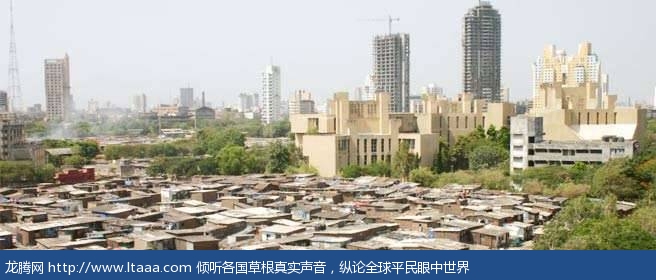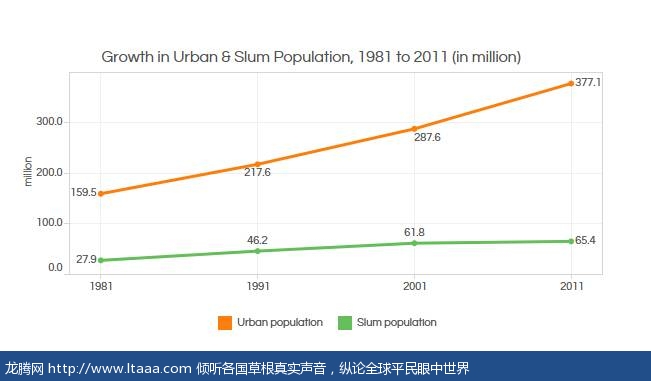洗涤报:印度城市贫民窟可塞满全意大利 [印度媒体]
印度近17%的城市人口生活在贫民窟,这个数字在过去三十年翻了一倍多,而印度的城市贫民窟可容纳全意大利。印度网友:我想知道为什么你不说法国而说意大利,也不管有一个比较接近的数字,6400万...表示疑问?
India’s City Slums Can House All Of Italy
新闻洗涤报:印度的城市贫民窟可容纳全意大利
Nearly 17% of India’s urban population live in slums, a number that has more than doubled over three decades.
印度近17%的城市人口生活在贫民窟,这个数字在过去三十年翻了一倍多。
It is reasonably well known that 31% of India’s population, or 377 million out of 1.2 billion people (when last counted in 2011), live in urban areas.
广为人知的是印度31%的人口,或12亿人(2011年最后的统计)的3.77亿人生活在城市地区。
What is not as well-known is that nearly 17% of this urban population, or more than 65 million people, lives in slums, a number that has more than doubled over three decades.
罕为人知的是这城市地区接近17%的人口,超过6500万人生活在贫民窟,数字在过去三十年翻了一倍多。
More Indians now live in slums than the number of people in Italy or the UK. The 30-year rise is the equivalent of adding the current population of Canada or Tanzania or two Syrias.
更多的印度人现在住在贫民窟,比意大利或英国的人口数还多。相当于加拿大和坦桑尼亚和两个叙利亚30年的增长加起来的人口总和。
(译注:从1980-2010年加拿大增长了约942万人、坦桑尼亚2628万人、叙利亚1257万人)
The Census of India defines a slum as a residential area where “dwellings are unfit for human habitation [due to] dilapidation, overcrowding, faulty arrangements and design of such buildings, narrowness or faulty arrangement of street, lack of ventilation, light, or sanitation facilities or any combination of these factors”.
印度人口普查将贫民窟以某一种住宅区的形式定义:"破旧、人满为患、建筑的设计和错误安排、街道狭窄或规划错误、缺乏通风和光线或卫生设施,或综合以上这些因素并不适合人类居住的住所"。
The number of urban poor has fallen 21% over six years, according to poverty estimates of the erstwhile Planning Commission.
据前任规划委员会的贫困估计,六年来,城市的贫民人数下降了21%。
Despite falling poverty, slums have been increasing in cities because they provide housing to millions who are not officially regarded as poor.
儘管贫困率正在下降,在城市的贫民窟仍不断增加,因为他们为数百万人提供住房,这些人不被官方认定为穷人。
Up to 53 million of 65 million slum-dwellers live below the poverty line, defined as the ability to spend Rs 1,000 for a family of four every month, according to the Planning Commission. The other 12 million belong to what are called “economically weaker sections”, with the ability to spend less than Rs 8,000 per family per month.
根据计划委员会定义一家四口每个月消费1000卢比的能力,6500万贫民窟居民中有5300万人生活在贫困线下。其他1200万人属于所谓的"经济弱势群众",每户家庭每月消费低于8000卢比。
Up to 88% of “economically weaker sections” and 11% of “lower-income groups”, (with the ability to spend between Rs 8,000 to Rs 16,000 per family per month), face housing shortages, according to the Ministry of Housing and Urban Poverty Alleviation.
根据印度住房和城市扶贫部的统计,高达88%的"经济弱势群众" 和11%的"低收入群体"(意指每户家庭每月能消费8000卢比到1万6000卢比的)面临住房紧张。
The housing shortage is now 19 million units (assuming a family of four, that would be 76 million people without homes and assuming a family of five, 95 million people), according to the ministry.
根据住房部统计,住房紧张的问题现在是1900万个单位(假设是一家四口,也就是7600万人没房住;假设是一家五口,也就是9500万人)。
As more Indians flock to cities, slums proliferate
随着越来越多的印度人涌向城市,贫民窟激增
The growth of slums is highest in the five states with the highest urban populations and is correlated with housing shortages and urban poverty.
贫民窟的增长在城市人口最多的五个邦最高,与住房紧张和城市贫困相关。
Almost 35% of the urban population in Andhra Pradesh lives in slums, followed by Maharashtra with 24%. So, about one in four Maharashtrian urban dwellers lives in a slum.
安得拉邦几乎35%的城市居民生活在贫民窟,其次是马哈拉施特拉邦的24%。因此,约四分之一的马哈拉施特拉的城市居民生活在贫民窟。
By 2020, India’s urban population is expected to increase to 590 million. The number of towns that reported slums has increased to 2,613 of a total of 4,041 statutory–or officially defined–towns of India in 2011, a 50% increase over 10 years.
到2020年,印度的城市人口预计将增加5.9亿。2011年印度共有4041个法定或官方定义的城镇,报告为贫民窟的城镇数量已增加到2613个,10年内增长了50%。
Put another way, out of 78.7 million urban households, 13.7 million households live in slums, which is almost 17% of the urban population. Of these 13.7 million households, 38% (5.2 million) live in million-plus cities. The majority stay in one-room houses, with four or more members.
换句话说,在7870万城市家庭中,1370万家庭生活在贫民窟,这几乎是城市人口的17%。在这1370万户家庭中,38%(520万)住在主要城市。大多数只留有一间房的住家,有四个或更多的家庭成员。
There is a clear link between urban poverty, housing shortages and a rising slum population. For example, Maharashtra has the highest slum population (10 million), the second highest number of people below the poverty line and the second-highest housing shortage, of about 1.9 million houses.
城市贫困、住房紧张和贫民窟人口上升之间有明显的联系。举例来说,马哈拉施特拉邦有最多的贫民窟人口(1000万),处于贫困线以下第二高和住房紧张第二高的数量,约190万户。
Prachi Salve writes for Indiaspend.org: a data-driven, public-interest journalism non-profit initiative.
帕契萨夫为印度数据网撰文,一个数据驱动,倡议型非营利的公共利益刊物。
funnyybonr •
I wondered why you din't mention France, but Italy, despite having a closer number, 64M..just a query?
我想知道为什么你不说法国而说意大利,也不管有一个比较接近的数字,6400万...表示疑问
Sid •
It's Anti Natuonal, Anti Hindu article.
这是敌视国家,反印度的文章。
Right •
Sau baat ki ek baat.
We are overpopulated despite impoverishment. We are a soft state that easily gets held to ransom by hooligans and collective madness.
Maybe only natural calamities, epidemics, destruction thru war , chemical leaks can probably remedy. Otherwise we are unlikely to get a satisfying solution unless if we rig statistics! !!!
直截了当说吧。
我们虽贫人多,我们是一个被流氓和集体疯狂轻易勒索的软弱政体。也许只有天灾、流行病、战争破坏、化学泄露能解脱,除非我们操纵统计,否则不太可能拿出满意的解决方案!
版权声明
我们致力于传递世界各地老百姓最真实、最直接、最详尽的对中国的看法
【版权与免责声明】如发现内容存在版权问题,烦请提供相关信息发邮件,
我们将及时沟通与处理。本站内容除非来源注明五毛网,否则均为网友转载,涉及言论、版权与本站无关。
本文仅代表作者观点,不代表本站立场。
本文来自网络,如有侵权及时联系本网站。
图文文章RECOMMEND
热门文章HOT NEWS
-
1
चाइना में रेडी और ठेले Local shops in china || L...
- 2
- 3
- 4
- 5
- 6
- 7
- 8
- 9
- 10
推荐文章HOT NEWS
-
1
चाइना में रेडी और ठेले Local shops in china || L...
- 2
- 3
- 4
- 5
- 6
- 7
- 8
- 9
- 10













